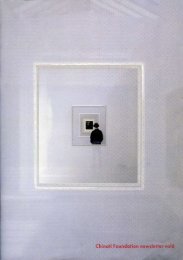Untitled - The Chinati Foundation
Untitled - The Chinati Foundation
Untitled - The Chinati Foundation
Create successful ePaper yourself
Turn your PDF publications into a flip-book with our unique Google optimized e-Paper software.
is a continuation of the traditional<br />
European representation of nature.<br />
<strong>The</strong>refore Albers’s work has to be<br />
disqualified instead of being recognized<br />
as different and as opposed.<br />
Instead of at least stating the conservative<br />
position and saying that the<br />
work isn’t art, which would seem<br />
intolerant, the intolerance has to be<br />
concealed by discrediting the work<br />
as pedagogical, which seems nicely<br />
objective, and as rational and cold,<br />
which seems warmly subjective, and<br />
as mechanical, of all things.<br />
<strong>The</strong> application of the paint in Albers’s<br />
paintings is hardly mechanical.<br />
It is instead, quiet, enjoyable and<br />
matter-of-fact, the latter somewhat<br />
like the application in Malevich’s<br />
paintings. It does at least two important<br />
things: it keeps the edges from<br />
being hard and turning into lines; it<br />
does not conceal the original surface,<br />
usually masonite. This allows the surface<br />
to be definitely a surface while<br />
keeping it light in weight and light<br />
as light, since it is a little transparent.<br />
It’s the one-hundredth inexpressive<br />
neo-expressionist who applies paint<br />
mechanically, then as well as now.<br />
<strong>The</strong> conclusion of Larson’s article and<br />
servadora, declarando que la obra no<br />
es arte, lo cual parecería intolerante,<br />
la intolerancia debe ser oculta, y se<br />
tacha a la obra de pedagógica (lo cual<br />
parece cómodamente objetivo) y de<br />
racional y fría (lo que parece calurosa-<br />
mente subjetivo) e, inexplicablemente,<br />
de mecánica.<br />
La aplicación de la pintura en las obras<br />
de Albers dista mucho de ser mecánica.<br />
Al contrario, es serena, agradable y ca-<br />
rente de efectismos, parecida en este úl-<br />
timo sentido al caso de Malevich. Logra<br />
dos cosas importantes: impide que los<br />
bordes se endurezcan y se conviertan<br />
en líneas, y no esconde la superficie ori-<br />
ginal, generalmente de masonite. Así se<br />
consigue que la superficie sea definiti-<br />
vamente superficie y al mismo tiempo<br />
que tenga ligereza de peso y claridad<br />
de luz, ya que es un tanto transparente.<br />
Sólo un inexpresivo neoexpresionista<br />
entre cien aplica la pintura mecánica-<br />
mente, tanto entonces como ahora.<br />
La conclusión del artículo de Larson, y<br />
la idea central del mismo, es la consa-<br />
bida defensa de la arquitectura “post-<br />
moderna”:<br />
El postmodernista, que respira complejidad<br />
y caos, sospecha de los sistemas, creyendo<br />
más bien que lo verdaderamente elemental<br />
64<br />
the main point is the standard defense<br />
of “post-modern” architecture.<br />
<strong>The</strong> postmodernist, steeped in complexity<br />
and chaos, is suspicious of systems, be-<br />
lieving instead that the truly elemental is<br />
a marvelously rich and unsettled state, a<br />
creative flux.<br />
“Post-modernist” architecture isn’t<br />
diverse and inventive. It’s a visible<br />
absence of thought. It’s complete<br />
poverty. It doesn’t matter whether<br />
it’s against systems; it’s operating<br />
in a system of ignorance. Standard,<br />
commercial, basically pre-fabricated<br />
structures are decorated with half a<br />
dozen very debased appearances<br />
of the past, not even ideas of the<br />
past. <strong>The</strong> reference is to be read by<br />
the ignorant tourist of both time and<br />
space. This and the equally superficial<br />
construction and materials are to<br />
be read casually as chic and playful<br />
and essentially as wealth and power.<br />
Except for the cuteness, this is like the<br />
international architecture of the twenties<br />
and thirties, even then that of all<br />
museums, generalized and pompous,<br />
that is, fascist. <strong>The</strong> house of the witch<br />
in Hänsel and Gretel is “post-modern.”<br />
Dallas and Frankfurt are whole<br />
villages.<br />
es un estado maravillosamente complejo y<br />
variable, un flujo creativo.<br />
La arquitectura “postmodernista” no es<br />
variada e innovadora. Es la ausencia<br />
visible del pensamiento. Es la pobreza<br />
absoluta. No importa si se opone a los<br />
sistemas porque está operando dentro<br />
de un sistema de ignorancia. Estructu-<br />
ras tradicionales, comerciales, esencial-<br />
mente prefabricadas son decoradas con<br />
media docena de apariencias muy de-<br />
gradadas del pasado, ni siquiera ideas<br />
del pasado. La referencia debe ser leída<br />
por el ignorante turista del tiempo y el<br />
espacio. Esto, y la construcción y ma-<br />
teriales igualmente superficiales, deben<br />
ser leídos a la ligera como elegantes y<br />
juguetones, y en esencia como riqueza<br />
y poder. Excepto por sus monerías, ésta<br />
es como la arquitectura internacional<br />
de los años veinte y treinta, aun enton-<br />
ces la de todos los museos, generali-<br />
zada y pomposa, es decir, fascista. La<br />
casa de la bruja en “Hansel y Gretel” es<br />
“postmoderna”. Dallas y Frankfurt son<br />
pueblos integrales.<br />
Antes de la conclusión, Larson comentó<br />
la relación de arte a ciencia, sostenien-<br />
do que entre 1910 y 1930:<br />
La pureza de la ciencia fue el ancla metafóri-<br />
ca del arte modernista.<br />
HOMAGE TO THE SQUARE, 1958, AS INSTALLED BY DONALD JUDD IN JUDD FOUNDATION BANK BUILDING.






